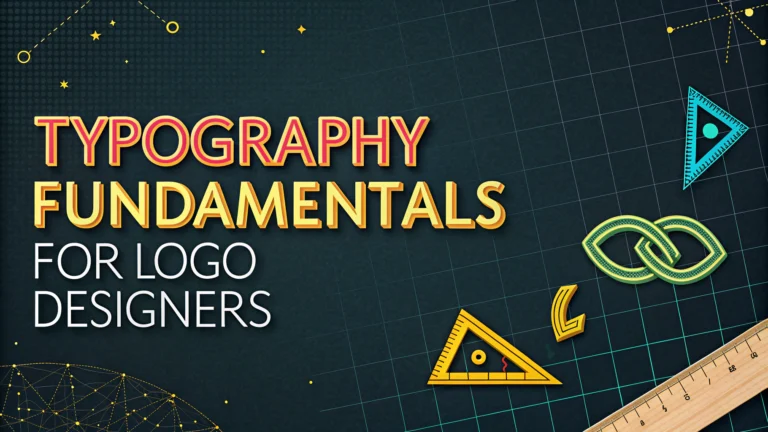Typography forms the backbone of effective logo design, shaping how brands communicate visually with their audience.
Let’s explore the essential typography principles every logo designer needs to master.
Font Selection Basics
Each font family carries its own personality and emotional impact:
- Serif fonts – Convey tradition, reliability, and sophistication
- Sans-serif fonts – Project modernity, cleanliness, and simplicity
- Script fonts – Express elegance, creativity, and personal touch
- Display fonts – Create unique, attention-grabbing statements
Technical Considerations
A logo must maintain legibility across different sizes and applications.
- Test fonts at multiple sizes (especially small scales)
- Ensure proper spacing between letters (kerning)
- Check readability in both color and black/white
- Verify font licensing for commercial use
Common Typography Mistakes to Avoid
- Using too many different fonts
- Choosing trendy fonts that may date quickly
- Poor kerning and letter spacing
- Ignoring scalability requirements
Recommended Typography Tools
- Adobe Fonts – Professional font library (fonts.adobe.com)
- Google Fonts – Free, quality typefaces (fonts.google.com)
- WhatTheFont – Font identification tool (myfonts.com/WhatTheFont)
- Fontstand – Font testing platform (fontstand.com)
Typography Best Practices
- Start with simple, classic fonts before exploring decorative options
- Consider the brand’s personality and target audience
- Test the logo across different backgrounds and contexts
- Keep modifications minimal and purposeful
- Document font choices and spacing measurements
Quick Reference Guide
| Brand Personality | Recommended Font Styles |
|---|---|
| Professional/Corporate | Clean sans-serif, modern serif |
| Creative/Artistic | Script, hand-drawn, display |
| Traditional/Classic | Serif, old-style typefaces |
| Modern/Tech | Geometric sans-serif, minimalist |
Working with Typography Combinations
When using multiple fonts in a logo, maintaining visual hierarchy and harmony becomes crucial:
- Limit combinations to 2-3 fonts maximum
- Create contrast through weight and style variations
- Maintain consistent proportions between elements
- Consider font families with multiple weights
Custom Typography Solutions
Sometimes standard fonts aren’t enough for unique brand requirements:
- Modified existing typefaces
- Custom letterform design
- Hand-lettered solutions
- Hybrid font combinations
Digital Adaptation
Modern logos must perform well across digital platforms:
- Social media profile pictures
- Mobile app icons
- Website favicons
- Email signatures
Conclusion
Successful logo typography requires balancing aesthetics with functionality. Focus on:
- Brand alignment and message clarity
- Technical excellence and versatility
- Long-term durability over trends
- Consistent implementation across platforms
Remember that typography in logo design is not just about choosing attractive fonts—it’s about creating lasting visual communication that serves the brand’s purpose effectively.
FAQs
- What are the most important typography elements to consider when designing a logo?
The key typography elements are legibility, readability, kerning, tracking, hierarchy, and font selection. These elements ensure your logo is both visually appealing and effectively communicates the brand message. - Which font categories are best suited for logo design?
The main font categories for logos are serif, sans-serif, script, display, and geometric fonts. Each category serves different purposes, with sans-serif being popular for modern brands and serif for traditional ones. - How many fonts should be used in a single logo design?
Generally, limit logo designs to one or two fonts maximum. Using too many fonts can make a logo appear cluttered and unprofessional, while reducing its scalability and recognition. - What is kerning and why is it crucial in logo typography?
Kerning is the adjustment of space between individual letter pairs. It’s crucial because proper kerning ensures visual balance and readability, particularly in wordmarks and typographic logos. - How do you ensure logo typography remains legible at different sizes?
Test the logo at various sizes, maintain adequate letter spacing, avoid extremely thin fonts, and ensure there’s sufficient contrast. The logo should be clearly readable from business card size to billboard scale. - What’s the difference between custom and ready-made fonts for logos?
Custom fonts are uniquely created for a specific brand, offering originality and exclusivity, while ready-made fonts are pre-existing typefaces available for public use. Custom typography can provide stronger brand identity but is typically more expensive. - How important is negative space in typographic logos?
Negative space is crucial for creating balance, readability, and sometimes hidden meanings in typographic logos. It helps prevent visual crowding and can be used creatively to form secondary images or symbols. - What role does font weight play in logo typography?
Font weight affects the visual hierarchy, emphasis, and overall impact of the logo. Heavier weights can convey strength and stability, while lighter weights might suggest elegance and sophistication. - Should logo typography follow current trends?
While it’s important to be aware of trends, logo typography should prioritize longevity and timelessness over current fads. A well-designed logo should remain effective and relevant for many years. - What are the legal considerations when selecting fonts for logos?
Ensure you have proper licensing for commercial use of fonts. Some fonts require special licenses for logo use, while others might be restricted. Always verify usage rights and consider purchasing commercial licenses.








